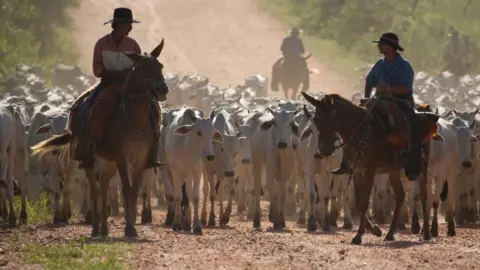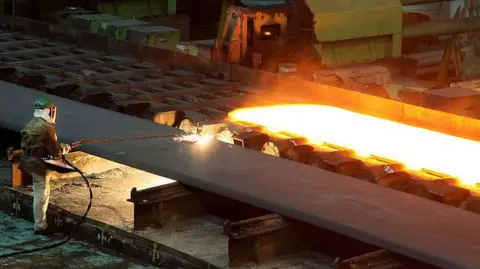South America correspondent
 Getty Images
Getty ImagesWhen Donald Trump revealed the level of trade tariffs that countries around the world would face from the US, nations in South America breathed a sigh of relief.
Ten of the 12 states on the continent received the lowest level of 10%.
Only Guyana and Venezuela were initially hit with higher rates of 38% and 15% respectively, before these were subsequently reduced to 10%. This came as Trump decided to pause elevated rates on almost all countries for 90 days.
The exceptions are China, which has been hit with 145%, and Canada and Mexico, which have still got 25% tariffs on some exports to the US.
Commentators who describe this as a win for South America argue that the higher US tariffs on China, and on Canada and Mexico, could make South American goods more attractive to US and global buyers.
While plausible, this view oversimplifies broader global trade instability that South America is also exposed to.
Here I’ll set out this debate – starting with the potential upsides for the region.
South America is rich in commodities. Its biggest economies – Brazil and Argentina – are major exporters of soybeans and petroleum as well as, in Brazil’s case, iron ore used in steel production.
The US’s huge tariffs on Chinese goods, and China’s retaliatory 125% on US imports, may create opportunities for South American exporters.
For example, Brazil could increase agricultural exports to China to replace previous US supplies. China is already Brazil’s largest export destination, followed by the US.
There is a precedent. When Trump hit China with tariffs during his first term of office, China shifted some commodity purchases from the US to Brazil, boosting Brazilian soybean exports.
With the 2025 soybean harvest in Brazil now continuing, some are hoping for a repeat.
These include Frederico D’Avila, a farmer and ex-politician aligned with former Brazilian President Bolsonaro. Mr D’Avila was also previously a senior figure at Aprosoja, a soybean producers’ group.
He tells the BBC that President Trump’s first term was “excellent for Brazilian agriculture” as “Trump’s tariffs in that time favoured us”.
 Getty Images
Getty ImagesHowever, Juan Carlos Hallak, professor of international economics at the University of Buenos Aires, has a counterpoint. He says that raising “bilateral barriers” on commodities mostly just affects “who sells to whom”, and not financial gains for the sellers – as the prices are set globally.
So his suggestion is that South American nations shouldn’t expect more financial gains from their commodities as a result of Trump’s actions, just potentially different customers.
“The prices are [instead] affected by macroeconomic factors… for example if there is a recession,” he tells the BBC.
Yet other sectors in South America are also hoping that Trump’s actions mean they could win more global sales as countries decide to buy less from the US.
Take the Brazilian beef industry. The country’s President Luiz Inácio Lula da Silva was recently in Japan, hoping to open the Japanese market to Brazil’s beef exports.
Japan currently buys 40% of its beef from the US. But after Trump initially threatened to hit the country with 24% tariffs, Tokyo may shift to buy more meat from South America.
Other Brazilian industries, such as coffee and footwear, may gain a competitive edge over their Asian counterparts in the US market.
Brazil is the world’s biggest producer of coffee, followed by Vietnam, Indonesia and Colombia.
Trump initially hit Vietnam with tariffs of 46% and Indonesia with 32%. While those higher rates are now on pause, if they are reinstated in July it will make beans from those two countries significantly more expensive in the US.
This would give both Brazilian and Colombian coffee a competitive advantage in the US, where they are already the main suppliers.
Meanwhile, Brazil’s shoemakers could see more exports to the US as a result of Trump’s high tariffs on Chinese exports. Currently China is the world’s largest manufacturer of footwear while Brazil is in fifth place.
The other three nations in the top five list of the world’s largest footwear producers are India, Vietnam and Indonesia. The US initially gave India a higher tariff rate of 26%.
Uruguay’s new President Yamandú Orsi has also said that Trump’s tariffs are helping to push a trade deal between the EU and South America’s bloc, Mercosur, closer to reality.
He said that “Europe has little choice now but to lower its demands somewhat” in negotiations, as it seeks to diversify trading partners.
You may have noted a lot of “coulds” and “ifs”. That’s not just because it is early days. It’s also because the pace and scale of US trade changes are causing wider instability.
Whether the potential positives for South America outweigh the potential negatives is hard to calculate accurately, which brings me to the risks for the continent.
Firstly, 10% is still 10%. Even countries with the lower tariff rate may face reduced US demand if prices rise. This is more of a risk for imports that compete with US domestic production, such as oil, soybeans, copper, iron ore, gold, and lithium.
The US has also hit imports of aluminium and steel, from all countries, with tariffs of 25%.
Brazil is a producer of both metals and has large reserves of their raw materials – bauxite and iron ore. Meanwhile, Argentina has one of the largest aluminium producers in South America, listed company Aluar, and a smaller steel industry.
Argentine producers warn they may both lose US access and face more Chinese imports, creating increased competition for domestic producers.
“We’re worried by the diversion of what can no longer enter the US,” Carlos Vaccaro, executive director of the Argentine Steel Chamber, told the Buenos Aires Herald.
 Getty Images
Getty ImagesTrump’s tariff wars have also led to global commodity price volatility, with oil and copper prices seeing slumps. Copper hit a 17-month low at the start of April. This volatility could hit the economies of Chile and Peru, where copper is the top export.
Eduardo Levy Yeyati, a former chief economist at the Central Bank of Argentina, says the impact on commodity prices and global demand is a “serious headwind” for South America.
Looking ahead, Mr Yeyati says that if Brazil and Argentina do end up enjoying a big rise in exports to the US, it could result in them getting higher tariffs from Trump.
After all, Trump’s aim is to boost domestic production, not imports from other countries.
Mr Yeyati says that Trump may be equally displeased if South American nations start exporting more to China. “If Brazil fills in the US quota of goods exports to China, the US may choose to punish Brazil.”
He theorises that Trump could also try to pressure Latin America to reduce China’s footprint in the region in return for favourable treatment. China invests billions of dollars in infrastructure projects across Central and South America.
So, calling Trump’s tariffs a clear “win” or “loss” for South America oversimplifies a complex situation. Especially if Trump announces in July that every country except China, Canada and Mexico will continue at 10%.
As Mr Hallak says: “It’s very hard to predict where this is going.”
Subject to this caveat, he envisions a future where the US protects its manufacturing industries more than its agricultural goods.
But adds: “I’m not sure Latin America is ready to take advantage of those opportunities. There will be specific opportunities for sure, but something that changes the game? I don’t think so.”

